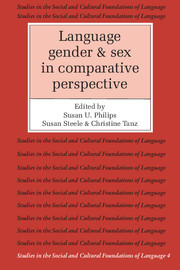Book contents
- Frontmatter
- Contents
- Acknowledgments
- List of contributors
- Introduction: The interaction of social and biological processes in women's and men's speech
- Part I Women's and men's speech in cross-cultural perspective
- Introduction
- 1 The womanly woman: manipulation of stereotypical and nonstereotypical features of Japanese female speech
- 2 The impact of stratification and socialization on men's and women's speech in Western Samoa
- 3 The interaction of variable syntax and discourse structure in women's and men's speech
- 4 A diversity of voices: men's and women's speech in ethnographic perspective
- 5 Women's speech in modern Mexicano
- Part II Gender differences in the language of children
- Part III Sex differences in language and the brain
- References
- Index
1 - The womanly woman: manipulation of stereotypical and nonstereotypical features of Japanese female speech
Published online by Cambridge University Press: 05 June 2012
- Frontmatter
- Contents
- Acknowledgments
- List of contributors
- Introduction: The interaction of social and biological processes in women's and men's speech
- Part I Women's and men's speech in cross-cultural perspective
- Introduction
- 1 The womanly woman: manipulation of stereotypical and nonstereotypical features of Japanese female speech
- 2 The impact of stratification and socialization on men's and women's speech in Western Samoa
- 3 The interaction of variable syntax and discourse structure in women's and men's speech
- 4 A diversity of voices: men's and women's speech in ethnographic perspective
- 5 Women's speech in modern Mexicano
- Part II Gender differences in the language of children
- Part III Sex differences in language and the brain
- References
- Index
Summary
This chapter will address the question of how, or whether, a subset of features identified as characteristic of female speech in a single language – Japanese – covaries across situations. Specifically, speech samples taken from situations in which women typically emphasize their femininity and situations in which they typically do not are compared to determine whether frequencies of occurrence of stereotypical morphological features and of nonstereotypical syntactic features vary in the same ways. That is, a first attempt is made to determine whether all the features identified as elements of Japanese women's speech are, in a straightforward way, part of a Japanese female speech register.
Linguistic investigations into the differences between men's and women's language and speech have been pursued with some intensity during the last decade, and many features of language form or patterns of language use exhibiting sex-related variation have been identified, particularly for English. A full elucidation of sex differences in language, however, requires a more systematically cross-cultural approach than has hitherto characterized the field. The reasons for this are twofold. First, although it has been suggested that differences in men's and women's speech are probably universal, the nature of that claim to universality is unclear and hence fails to be an interesting source of explanation for linguistic fact.
- Type
- Chapter
- Information
- Language, Gender, and Sex in Comparative Perspective , pp. 26 - 49Publisher: Cambridge University PressPrint publication year: 1987
- 14
- Cited by



